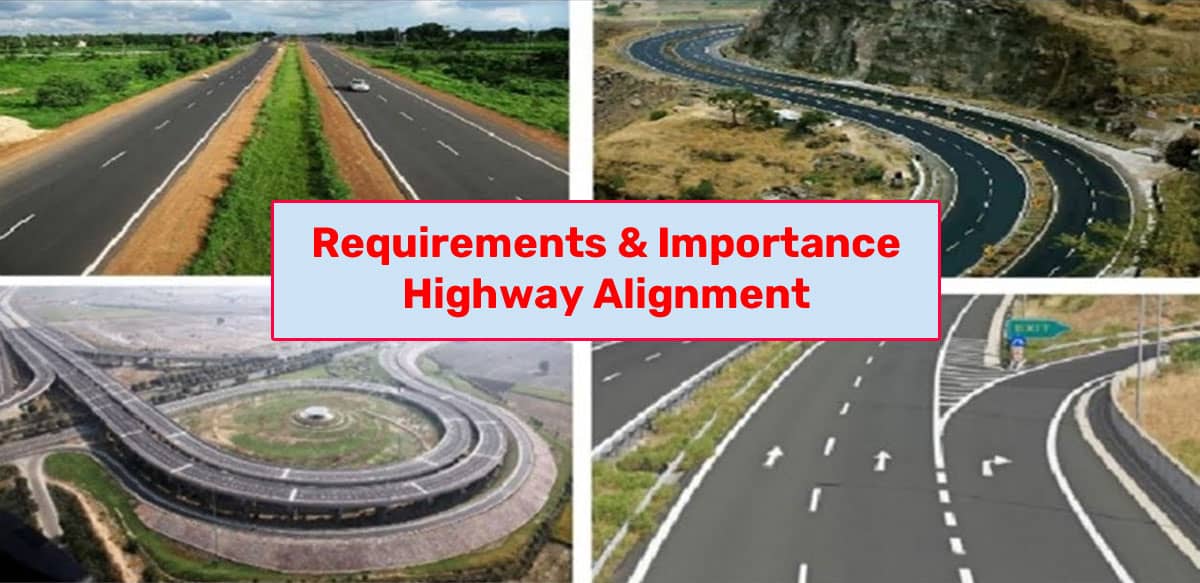Requirements & Importance Highway Alignment

It is common to encounter highway alignment when designing and planning highways. You must understand them as a civil engineer. To determine the highway alignment, you must first decide on a road construction plan. Following the determination of the necessity for the highway, the alignment must be determined. In the following sections, we will detail how highways can be aligned horizontally or vertically.
Define Alignment
The alignment of a highway is its position or layout on the ground. Curved and straight paths make up the horizontal alignment. Levels and gradients make up the vertical alignment.
Good alignments improve construction, maintenance, and vehicle operating costs, while bad alignments increase these costs. After an alignment has been finalized and constructed, it is hard to change it. As a result, adjacent land costs increase & expensive structures are built along the roadside.
Define Highway Alignment
As the name implies, highway alignment is a diagram showing the location of the central line of a highway on the ground or the planned route. Highway alignments can be divided into two categories.
Types of Highway Alignment
Vertical Alignment
Viewing a road alignment from a perspective front or side helps you understand vertical alignment. Leveling, slope analysis, and analysis of gradients happen in Vertical Alignment.
Horizontal Alignment
Whether a road is straight or curved, this covers its horizontal path. Viewed from the top, the alignment of a road is horizontal.
Requirements of Highway Alignment
- Although practical considerations may require some deviations, it is recommended that a straight alignment be maintained between two terminal stations.
- Constructing and maintaining the alignment should be straightforward. Vehicles should be able to operate on it. To this end, gradients should be as easy as possible.
- From the point of view of both construction and operation, slopes, embankments, and cuts must be safe. Their geometric features should ensure safety.
- If the initial costs, maintenance costs, and operating costs are low, then the alignment can be considered economically viable.
Key Factors of Controlling Highway Alignment
Obligatory Points
These control points determine the alignment of highways. There are two types of control points. You can designate where it should pass and where it shouldn't.
Alignment Should Pass
Developing the areas requires the construction of roads. The alignment of a highway may be acceptable if it passes through places such as towns, villages, and cities.
A tunnel or a route that goes around the hills should consider if the alignment passes through a mountain. There are several factors to consider when choosing a choice, such as topography, site conditions, and construction and operation costs.
Alignment Should not Pass
If an alignment crosses a small lake or pond, it deviates from it to some extent. The construction of bridges over these lakes and ponds costs more.
Acquiring land at these places entails considerable initial costs, and demolishing these structures takes more time and money. It is best for the alignment to avoid developed areas or areas with high-rise building structures. In other words, if the points above these are in alignment, the slight deviation in alignment is acceptable. The alignment should avoid crossing agricultural lands and dense forests.
To learn more, watch the following video tutorial.
Traffic
The alignment must accommodate traffic. The areas' origin and destination data should draw the lines. Lines, traffic patterns should all be considered when designing it.
All previous data of traffic is considered when analyzing both the volume and increase in the annual volume of traffic. Alignment is then determined by considering both of these data. When the traffic is fast and vehicular, it keeps the alignment straight with fewer curves. It would be helpful to construct dedicated lanes for fast vehicles.
Geometric Design
The alignment of the highway is shaped by geometry, including gradient, the radius of the curve, sight distance, etc. Possibly the highway alignment needs to be changed to keep the radius of the curve as small as possible. Finalize alignments that do not restrict visibility so that minimum sight distances are not impacted. Depending on the terrain and the type of road, the alignment of the highway will differ.
Importance of Highway Alignment
Alignment Should Pass
Developing the areas requires the construction of roads. The alignment of a highway may be acceptable if it passes through places such as towns, villages, and cities.
Beams or trusses span the core and perimeter frames. They transfer gravitational loads between them. As a result, the perimeter tube is more effective at preventing overturning moments caused by lateral loads.
